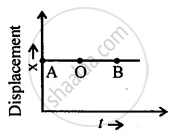Advertisements
Advertisements
प्रश्न
Figure shows the displacement of a body at different times .
Calculate the velocity of the body as it moves for time interval :
(i) 0 to 5 s,
(ii) 5 s to 7 s
(iii) 7 s to 9 s.

उत्तर
(a) (i) Velocity from 0 to 5 s = Displacement /time
= (3/5) m/s
= 0.6 m/s-1
(ii) Velocity from 5 s to 7 s = Displacement /time
= (0/2) m/s
= 0 m/s-1.
(iii) Velocity from 7 s to 9 s = Displacement /time
= (7 - 3)/(9 - 7) m/s
= (4/2) m/s
= 2 m/s-1
APPEARS IN
संबंधित प्रश्न
Under what condition(s) is the magnitude of average velocity of an object equal to its average speed?
State whether speed is a scalar or a vector quantity. Give reason for your choice.
A motorcyclist drives from place A to B with a uniform speed of 30 km h-1 and returns from place B to A with a uniform speed of 20 km h-1. Find his average speed.
A car travels 100 km at a speed of 60 km/h and returns with a speed of 40 km/h. Calculate the average speed for the whole journey.
A ball hits a wall horizontally at 6.0 m s-1. It rebounds horizontally at 4.4 m s-1. The ball is in contact with the wall for 0.040 s. What is the acceleration of the ball ?
Which of the quantity-velocity or acceleration-determines the direction of motion?
A train travels with a speed of 60 km h-1 from station A to station B and then comes back with a speed 80 km h-1 from station B to station A. Find -
- The average speed
- The average velocity of the train.
A body projected vertically up with a velocity of 10 m/s reaches a height of 20 m. If it is projected with a velocity of 20 m/s, then the maximum height reached by the body is:
Write down the type of motion of a body along with the A – O – B of the following distance – time graph.

Derive th e equation of motion.
S = ut+ `1/2` at2,
Where the symbols have their usual meanings
